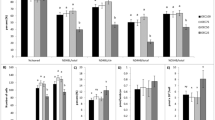Abstract
Purpose: To examine the effect of essential amino acids concentrations on mouse embryo development.
Methods: Mouse embryos were cultured in medium with different concentrations of essential amino acids and development to the blastocyst stage and viability assessed. Ammonium production resulting from medium breakdown and amino acid metabolism by embryos were also assessed.
Results: Reducing the essential amino acid concentration significantly increased blastocyst development and cell numbers. Lowering the essential amino acid concentration decreased ammonium production in the medium.
Conclusions: Culture media for the development of preimplantation embryos should have a reduced essential amino acid concentration to facilitate embryo development.
Similar content being viewed by others
REFERENCES
Gardner DK, Lane M: Amino acids and ammonium regulate mouse embryo development in culture. Biol Reprod 1993;48:377-385
Biggers JD, McGinnis LK, Raffin M: Amino acids and preimplantation development of the mouse in protein-free potassium simplex optimized medium. Biol Reprod 2000;63:281-293
Carney EW, Bavister BD: Stimulatory and inhibitory effects of amino acids on the development of hamster eight-cell embryos in vitro. J In Vitro Fert Embryo Transf 1987;4:162-167
Pinyopummintr T, Bavister BD: Effects of amino acids on development in vitro of cleavage-stage bovine embryos into blastocysts. Reprod Fertil Dev 1996;8:835-841
Gardner DK, Lane M: Alleviation of the '2-cell block' and development to the blastocyst of CF1 mouse embryos: Role of amino acids, EDTA and physical parameters. Hum Reprod 1996;11:2703-2712
Lane M, Gardner DK: Increase in postimplantation development of cultured mouse embryos by amino acids and induction of fetal retardation and exencephaly by ammonium ions. J Reprod Fertil 1994;102:305-312
Lane M, Gardner DK: Differential regulation of mouse embryo development and viability by amino acids. J Reprod Fertil 1997;109:153-164
Lane M, Gardner DK: Amino acids and vitamins prevent culture-induced metabolic perturbations and associated loss of viability of mouse blastocysts. Hum Reprod 1998;13:991-997
Rosenkrans CF, First NL: Effect of free amino acids and vitamins on cleavage and developmental rate of bovine zygotes in vitro. J Anim Sci 1994;72:434-437
Eagle H: Amino acid metabolism in mammalian cell cultures. Science 1959;130:432-437
Lane M, Gardner DK: Nonessential amino acids and glutamine decrease the time of the first three cleavage divisions and increase compaction of mouse zygotes in vitro. J Assist Reprod Genet 1997;14:398-403
Miller JG, Schultz GA: Amino acid content of preimplantation rabbit embryos and fluids of the reproductive tract. Biol Reprod 1987;36:125-129
Gardner DK, Lane M: Culture of viable human blastocysts in defined sequential serum-free media. Hum Reprod 1998;13(Suppl. 3):148-159
Steeves TE, Gardner DK: Temporal and differential effects of amino acids on bovine embryo development in culture. Biol Reprod 1999;61:731-740
Gardner DK, Lane M: Culture and selection of viable blastocysts: A feasible proposition for human IVF? Hum Reprod Update 1997;3:367-382
Gardner DK, Schoolcraft WB, Wagley L, Schlenker T, Stevens J, Hesla J: A prospective randomized trial of blastocyst culture and transfer in in-vitro fertilization. Hum Reprod 1998;13:3434-3440
Gardner DK: Development of serum-free media for the culture and transfer of human blastocysts. Hum Reprod 1998;13(Suppl. 4):218-225
Hardy K, Handyside AH, Winston RM: The human blastocyst: Cell number, death and allocation during late preimplantation development in vitro. Development 1989;107:597-604
Gardner DK, Lane MW, Lane M: EDTA stimulates cleavage stage bovine embryo development in culture but inhibits blastocyst development and differentiation. Mol Reprod Dev 2000;57:256-261
McKiernan SH, Clayton MK, Bavister BD: Analysis of stimulatory and inhibitory amino acids for development of hamster one-cell embryos in vitro. Mol Reprod Dev 1995;42:188-199
Author information
Authors and Affiliations
Rights and permissions
About this article
Cite this article
Lane, M., Hooper, K. & Gardner, D.K. Animal Experimentation: Effect of Essential Amino Acids on Mouse Embryo Viability and Ammonium Production. J Assist Reprod Genet 18, 519–525 (2001). https://doi.org/10.1023/A:1016657228171
Issue Date:
DOI: https://doi.org/10.1023/A:1016657228171




